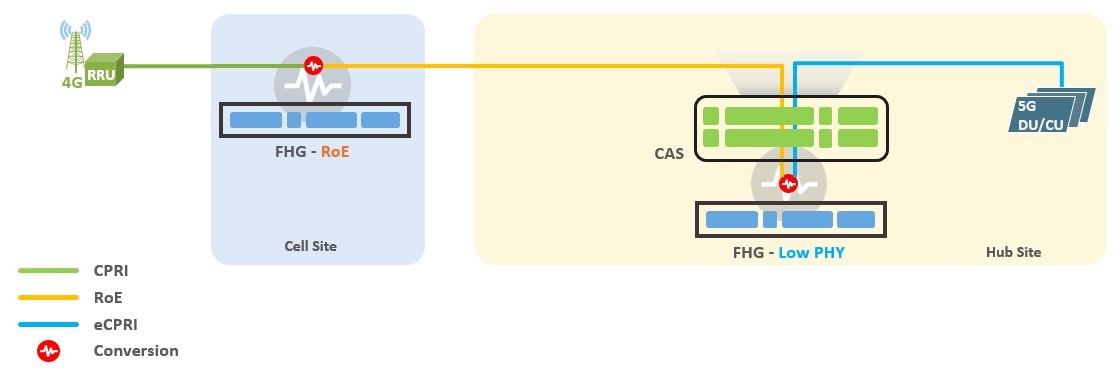Application Scenarios for 5G Fronthaul Gateways
by Andrew Lui

The 5G fronthaul gateway allows telecoms to transition smoothly from a 4G RAN (Radio Access Network) to a 5G RAN by enabling the communications between the RRU (Remote Radio Unit) and BBU (Baseband Unit) using both CPRI and eCPRI. However, a standard 5G RAN is still being defined and there are several different application scenarios being explored, which got me wondering. What are the potential application scenarios of the 5G fronthaul?
There are four major types of scenarios identified for the 5G fronthaul:
- RoE Fronthaul Conversion
- LowPHY Fronthaul Conversion
- RoE to LowPHY Fronthaul Conversion
- PICO Fronthaul Conversion
Let’s go more into details for each scenario to see how it’s being applied and how we designed a flexible 5G fronthaul gateway with our partner, Altran (part of the Capgemini Group), that can potentially be used for any type of 5G fronthaul scenario.
RoE (Radio over Ethernet) Fronthaul Conversion
Let’s say you’re rolling out 5G and you want to install 5G RRUs at your cell sites. You want to implement a BBU hotel to cut down on costs, but your 4G and 5G BBUs haven’t been integrated yet, so they are still separate at the hub site. This means, not only do you need to aggregate both the 4G/5G RRUs, you also need to revert the signals back to their respective BBUs. In this scenario the RoE conversion feature of our 5G fronthaul gateway would come in handy.
Our 5G fronthaul gateway utilizes the Radio over Ethernet (RoE) protocol, which allows 4G radio traffic to be sent over standard Ethernet. This is done by encapsulating 4G into Ethernet frames at the cell site with the fronthaul gateway and using another fronthaul gateway to decapsulate it back to CPRI at hub site before feeding it to the 4G BBU. The decapsulation is needed at the hub site because the 4G BBUs are still using CPRI. At the same time, the 5G traffic is sent directly to the 5G BBU using eCPRI. The Converged Access Switch (CAS) acts as an aggregation switch to aggregate multiple fronthaul gateways at the hub site.
Using RoE conversions at the fronthaul gateway, you do not need to wait until your 4G and 5G BBUs are completely pooled together to take advantage of the BBU hotel, which leads to faster time to market for your cost down solution.
LowPHY Fronthaul Conversion
As the RAN develops, there will most likely be a time when all the BBUs are pooled together while the 4G RRUs are still active. It’s not like 5G will replace 4G right away, so very likely most brownfield projects will end up in a scenario like this one. When this happens a CPRI to eCPRI conversion would be ideal for 4G fronthaul to the 5G DU/CUs.
In this case, our 5G fronthaul gateway takes on the BBU LowPHY processing and converts 4G CPRI to eCPRI at the cell site, which allows for a fronthaul of just eCPRI to the hub site DU/CU. You’ll notice a major difference in this scenario compared to the RoE conversion is that since the 4G RRU’s radio is already converted to eCPRI, there is no need for another fronthaul gateway conversion at the hub site. Therefore, the CAS will aggregate all the eCPRI signals from multiple fronthaul gateways and switch it to the 5G DU/CU pool.
This scenario would be more geared towards the end goal of a 4G/5G RAN with optimized BBU pooling. Since the BBU LowPHY processing is done at the 5G fronthaul gateway, there is also significant bandwidth savings and costs. This also supports the functional 7.2x split from ORAN standard.
RoE (Radio over Ethernet) to LowPHY Fronthaul Conversion
Here’s where things get a little tricky and we start to explore alternative scenarios that may happen during the transition to 5G DU/CUs. In this scenario, Ethernet to Ethernet transport protocol is required between the 4G cell site and 5G DU/CU at the hub site. This may come into play in areas where 5G DU/CU pooling was completed before all the cell sites were upgraded with 5G or at cell sites simply for 4G coverage.
In this scenario, the CPRI is encapsulated at the cell site with a RoE enabled fronthaul gateway and aggregated at the hub site by the converged access switch. Then the CPRI will be converted to eCPRI using a LowPHY enabled fronthaul gateway before sending it back to the CAS to be switched to the DU/CU pool.
Deploying the LowPHY fronthaul gateway at the hub site will not provide the bandwidth benefits realized from deploying it at the cell site, however, it is a secondary solution for utilizing 5G DU/CU pooling if LowPHY conversion at the cell site is not available.
PICO Fronthaul Conversion
At some cell sites, there just isn’t enough room or power to install a fronthaul gateway. In these scenarios, CPRI can be converted at the hub site similar to the scenarios above. It’ll be converted to eCPRI from a LowPHY fronthaul gateway at the hub site and sent to the 5G DU/CU pool.
5G Fronthaul Challenges and Potential Future Application Scenarios
It goes without saying, that the scenarios described above may not encompass all that is to come for 5G fronthaul application scenarios. (For example, we didn’t even mention varying port requirements or how the placement of DUs and CUs would affect the fronthaul.) But it should give you an idea of some of the major scenarios identified and begin to think which one would suit your RAN architecture.
One question you may be asking is, with all these scenarios, just how many fronthaul gateway variations would I need? Here’s a list of some 5G fronthaul challenges:
- Choosing between RoE vs LowPHY
- Varying quantities of RRUs that need to be aggregated at each cell site
- Multiple timing protocols
- All the different vendors for RRU and BBU
Would you be surprised if I told you that you only need one fronthaul gateway to meet all these challenges?
Defining Characteristics of a Flexible 5G Fronthaul Gateway
Working with our partner, Altran, we set forth on a journey to design and develop a 5G fronthaul gateway that would fit into most, if not all, of the scenarios mentioned above and much more. Our goal is to provide Telecoms with a solution to implement a 5G fronthaul now that has the flexibility to meet future 5G application scenarios. Thus, allowing our customers to invest in their RAN knowing that they will save time, money, and management headaches by utilizing one fronthaul gateway to meet any scenario.
To create such a solution, our flexible 5G fronthaul gateway has meet the following characteristics:
1. Timing
For 5G, the timing accuracy is more critical than ever. In a fronthaul network, the time difference must be under 3 microseconds and for some critical applications, it will be within nanoseconds. Our in-house Network Timing Module provides ITU-T Class C precision to guarantee the time error within 10 nanoseconds.
A flexible 5G fronthaul gateway should meet the multiple standards that are defined to enhance the time precision over the network. Synchronous Ethernet (SyncE) is an ITU-T standard to provide frequency synchronization over a physical interface while Precision Time Protocol (PTP, IEEE1588v2) is designed to exchange time information over the packet network.
2. Modularity
Telecommunication is a highly geographical-dependent segment, especially in the fronthaul. Various configurations are needed for different deployment scenarios (in addition to those mentioned above), which means there is no one-size-fits-all solution. However, to get around that, we designed the service ports of our fronthaul gateway to be modularized built with power field programmable gate array (FPGAs), which can be customized to support different pluggable standards, ports count and new features.
3. Programmability
Due to the complexity of the 5G fronthaul, not all standards will be suitable for mass commercialization, nor will it be readily available via mainstream vendors. Equipped with field upgradable FPGA, UfiSpace and our partner, Altran, are working together to realize cutting-edge features such as RoE encapsulation with support for LowPHY eCPRI conversion, when the technology and infrastructure is ready.
Furthermore, our comprehensive SDKs can enable front panel ports to be programmed for different functions according to the field application. For example, in an urban city we might require more eCPRI interfaces while at more rural areas CPRI is still the majority. Therefore, the service ports on the 5G fronthaul gateway can be dynamically configured to have more eCPRI interfaces when deployed in cities and more CPRI in a rural setting.
4. Multi-Vendor Openness
The vision for the future of network is openness, where all the solutions from different vendors can be integrated seamlessly. Working with Altran, we are moving towards a multi-vendor compliance to embrace the open world. From a hardware perspective, UfiSpace guarantees the interoperability on the physical layer with other devices while Altran’s ISS platform is responsible for the communication on control and management plane with other systems.
With such characteristics our 5G fronthaul gateway isn’t limited to just packet fronthaul. Our modularized and programmable design enables our fronthaul gateways to be programmed for various purposes, such as leveraging the SerDes on board to develop different applications such as R-HUB, RF transmitter, OTN or even transponders. This truly allows telecoms to get the best value from their fronthaul investment and create a flexible infrastructure to meet all the possible scenarios that will evolve from 5G.




